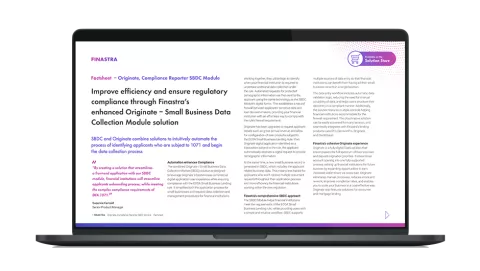The evolution of corporate lending (White Paper)
The corporate banking sector is facing ongoing challenges while simultaneously striving to achieve a delicate balance: reducing costs, modernizing systems, removing technology deficit, and enhancing customer service. However, legacy systems pose obstacles to implementing interconnected processes necessary for swift responses to corporate loan requests. Furthermore, addressing data quality, accessibility, and standardization remains crucial. Despite these imperatives, banks need to continue moving forward with technology modernization to offer optimal lending products and services to their customers.

Default Finastra
The corporate banking industry faces multiple challenges, including a high-interest-rate economy, an unpredictable global socio-economic environment, data management hurdles, addressing technology deficits, and competing with new market entrants. Financial institutions grapple with increased corporate loan volumes while striving to reduce operational costs and invest in modern IT.
Technology represents a differentiator factor, enabling automation, AI and GenAI, cloud systems, and API-based architecture to build the infrastructure resilience and position banks at the forefront of competition by delivering a cutting-edge, seamless customer experience. Managing large loan volume growth is feasible only through technology adoption, and robust systems directly correlate with data quality.
Standard identifiers play a pivotal role in improving standardization, transparency, and streamlined data access. Depending on priorities, region, and modernization processes, corporate banks progress through various stages of AI and GenAI trials and adoption. Leveraging the power of AI and GenAI accelerates areas like loan origination, financial spreading, deal booking, and servicing.
When building modern platforms, the buy-versus-build dilemma persists. Historically, in-house development maintained up-to-date IT platforms, creating unique solutions tailored to banks’ processes and legacy systems. However, fintechs now offer flexible, cost-effective alternatives, minimizing time-to-market and maintenance responsibilities for the banks.
These systems seamlessly integrate with existing infrastructure, ensuring easy scalability, automated regulatory compliance, and a smooth operability. Despite the many factors and variables that need to be taken into consideration in modernizing systems, data quality and standardization remain critical challenges within this maze of platforms.


